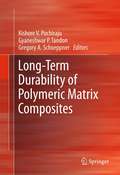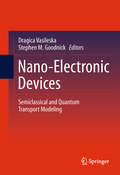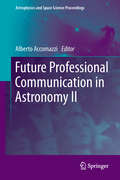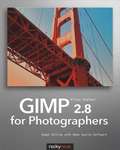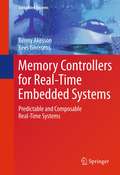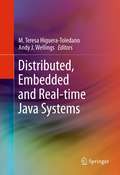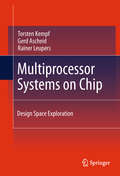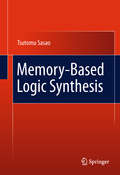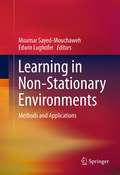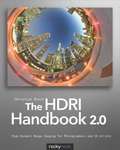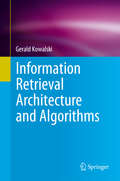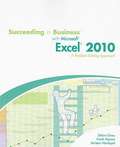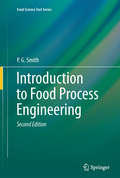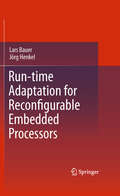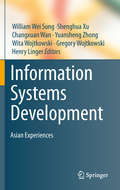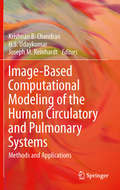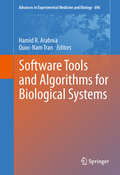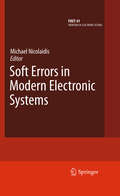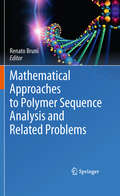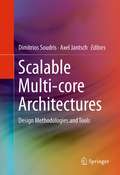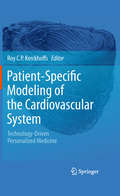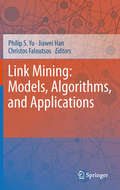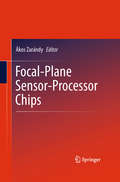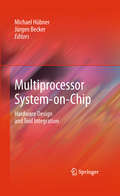- Table View
- List View
Long-Term Durability of Polymeric Matrix Composites
by Gyaneshwar P. Tandon Gregory A. Schoeppner Kishore V. PochirajuLong-Term Durability of Polymeric Matrix Composites presents a comprehensive knowledge-set of matrix, fiber and interphase behavior under long-term aging conditions, theoretical modeling and experimental methods. This book covers long-term constituent behavior, predictive methodologies, experimental validation and design practice. Readers will also find a discussion of various applications, including aging air craft structures, aging civil infrastructure, in addition to engines and high temperature applications.
Nano-Electronic Devices
by Stephen M. Goodnick Dragica VasileskaThis book surveys the advanced simulation methods needed for proper modeling of state-of-the-art nanoscale devices. It systematically describes theoretical approaches and the numerical solutions that are used in explaining the operation of both power devices as well as nano-scale devices. It clearly explains for what types of devices a particular method is suitable, which is the most critical point that a researcher faces and has to decide upon when modeling semiconductor devices.
Future Professional Communication in Astronomy II
by Alberto AccomazziThe present volume gathers together the talks presented at the second colloquim on the Future Professional Communication in Astronomy (FPCA II), held at Harvard University (Cambridge, MA) on 13-14 April 2010. This meeting provided a forum for editors, publishers, scientists, librarians and officers of learned societies to discuss the future of the field. The program included talks from leading researchers and practitioners and drew a crowd of approximately 50 attendees from 10 countries. These proceedings contain contributions from invited and contributed talks from leaders in the field, touching on a number of topics. Among them: - The role of disciplinary repositories such as ADS and arXiv in astronomy and the physical sciences; - Current status and future of Open Access Publishing models and their impact on astronomy and astrophysics publishing; - Emerging trends in scientific article publishing: semantic annotations, multimedia content, links to data products hosted by astrophysics archives; - Novel approaches to the evaluation of facilities and projects based on bibliometric indicators; - Impact of Government mandates, Privacy laws, and Intellectual Property Rights on the evolving digital publishing environment in astronomy; - Communicating astronomy to the public: the experience of the International Year of Astronomy 2009.
GIMP 2.6 for Photographers
by Klaus GoelkerImage editing has become a crucial element in the photographic workflow. Image editing tools, most notably Photoshop, are usually sophisticated and deep applications, and are fairly expensive. The only open source tool in this market is the GIMP, which has developed into a powerful, multiplatform system running on Linux, Mac OS X, and Microsoft Windows. GIMP 2.6 for Photographers is a beginner's guide to the only open source image editing tool that provides a low-cost alternative to expensive programs such as Photoshop. Topics include the basics of image editing and simple adjustments, as well as advanced techniques using layers and masks, stitching panoramic images, and preparing high-quality black and white images. The most important editing functions are presented in individual, easy-to-follow workshops. GIMP 2.6 for Photographers has evolved from classroom materials that the author developed and taught in courses and workshops on image editing with the GIMP.
Memory Controllers for Real-Time Embedded Systems
by Kees Goossens Benny AkessonVerification of real-time requirements in systems-on-chip becomes more complex as more applications are integrated. Predictable and composable systems can manage the increasing complexity using formal verification and simulation. This book explains the concepts of predictability and composability and shows how to apply them to the design and analysis of a memory controller, which is a key component in any real-time system.
Distributed, Embedded and Real-time Java Systems
by M. Teresa Higuera-Toledano Andy J. WellingsResearch on real-time Java technology has been prolific over the past decade, leading to a large number of corresponding hardware and software solutions, and frameworks for distributed and embedded real-time Java systems. This book is aimed primarily at researchers in real-time embedded systems, particularly those who wish to understand the current state of the art in using Java in this domain. Much of the work in real-time distributed, embedded and real-time Java has focused on the Real-time Specification for Java (RTSJ) as the underlying base technology, and consequently many of the Chapters in this book address issues with, or solve problems using, this framework. Describes innovative techniques in: scheduling, memory management, quality of service and communication systems supporting real-time Java applications;Includes coverage of multiprocessor embedded systems and parallel programming;Discusses state-of-the-art resource management for embedded systems, including Java's real-time garbage collection and parallel collectors;Considers hardware support for the execution of Java programs including how programs can interact with functional accelerators;Includes coverage of Safety Critical Java for development of safety critical embedded systems.
Multiprocessor Systems on Chip
by Rainer Leupers Torsten Kempf Gerd AscheidThis book gives a comprehensive introduction to the design challenges of MPSoC platforms, focusing on early design space exploration. It defines an iterative methodology to increase the abstraction level so that evaluation of design decisions can be performed earlier in the design process. These techniques enable exploration on the system level before undertaking time- and cost-intensive development.
Memory-Based Logic Synthesis
by Tsutomu SasaoThis book describes the synthesis of logic functions using memories. It is useful to design field programmable gate arrays (FPGAs) that contain both small-scale memories, called look-up tables (LUTs), and medium-scale memories, called embedded memories. This is a valuable reference for both FPGA system designers and CAD tool developers, concerned with logic synthesis for FPGAs.
Learning in Non-Stationary Environments
by Moamar Sayed-Mouchaweh Edwin LughoferRecent decades have seen rapid advances in automatization processes, supported by modern machines and computers. The result is significant increases in system complexity and state changes, information sources, the need for faster data handling and the integration of environmental influences. Intelligent systems, equipped with a taxonomy of data-driven system identification and machine learning algorithms, can handle these problems partially. Conventional learning algorithms in a batch off-line setting fail whenever dynamic changes of the process appear due to non-stationary environments and external influences. Learning in Non-Stationary Environments: Methods and Applications offers a wide-ranging, comprehensive review of recent developments and important methodologies in the field. The coverage focuses on dynamic learning in unsupervised problems, dynamic learning in supervised classification and dynamic learning in supervised regression problems. A later section is dedicated to applications in which dynamic learning methods serve as keystones for achieving models with high accuracy. Rather than rely on a mathematical theorem/proof style, the editors highlight numerous figures, tables, examples and applications, together with their explanations. This approach offers a useful basis for further investigation and fresh ideas and motivates and inspires newcomers to explore this promising and still emerging field of research.
The HDRI Handbook 2.0
by Christian BlochHigh dynamic range imaging (HDRI) takes photography to a whole new level. It opens the door to unprecedented creative freedom in digital post-processing by capturing everything from the darkest shadows to the brightest highlights. HDRI means truly lossless image editing, full exposure control, and the ability to master any scene's contrast without artificial lighting and preserve all light from a scene so it can be digitally revisited anytime in the future. Combined with panoramic photography, this captured light can even be used to render 3D objects with a deceivingly realistic appearance. In 2007, The HDRI Handbook was the first book to present this revolutionary new field to a larger audience. These days HDRI is a fully mature technology available to everyone. Real estate and landscape photographers have adopted it as part of their regular workflow, it has become one of the hottest trends for ambitious amateurs and creative professionals alike, and the modern movie industry would be completely dysfunctional without it. Now The HDRI Handbook 2. 0 redefines its own gold standard. It has been completely rewritten and is packed with practical hints and tips, background knowledge, reference tools, breathtaking artist portfolios, and inspiring interviews. The book includes dozens of new step-by-step tutorials, which are easy to follow with the material provided on the DVD. Beginners will get a methodically solid introduction and advanced readers will be able to refine their technique to perfection. Whether you are a photographer, CG artist, compositor, or cinematographer, this book is sure to enlighten you. Topics include: Understanding the foundation of HDRI HDR software comparisons and evaluations Capturing HDR images: today and tomorrow Tonemapping for creating superior prints HDR image processing and compositing Shooting and stitching HDR panoramas Image-based lighting and CG rendering 2. 0 updates include: New cameras, sensors, and HDR beamsplitter rigs Open Camera Controller for endless auto-bracketing Correct RAW pre-processing and ghost removal Dozens of practical, easy-to-follow tutorials A structured approach to tonemapping, inspired by Ansel Adams Set etiquette and tips for capturing HDR panos for visual effects Seven artist spotlights showing unique perspectives on HDRI Seven crossword puzzles: a fun way to test yourself A companion DVD loaded with goodies
Information Retrieval Architecture and Algorithms
by Gerald KowalskiThis text presents a theoretical and practical examination of the latest developments in Information Retrieval and their application to existing systems. By starting with a functional discussion of what is needed for an information system, the reader can grasp the scope of information retrieval problems and discover the tools to resolve them. The book takes a system approach to explore every functional processing step in a system from ingest of an item to be indexed to displaying results, showing how implementation decisions add to the information retrieval goal, and thus providing the user with the needed outcome, while minimizing their resources to obtain those results. The text stresses the current migration of information retrieval from just textual to multimedia, expounding upon multimedia search, retrieval and display, as well as classic and new textual techniques. It also introduces developments in hardware, and more importantly, search architectures, such as those introduced by Google, in order to approach scalability issues. About this textbook: A first course text for advanced level courses, providing a survey of information retrieval system theory and architecture, complete with challenging exercisesApproaches information retrieval from a practical systems view in order for the reader to grasp both scope and solutionsFeatures what is achievable using existing technologies and investigates what deficiencies warrant additional exploration
Succeeding in Business with Microsoft Excel 2010: A Problem-solving Approach
by Debra Gross Frank Akaiwa Karleen NordquistSUCCEEDING IN BUSINESS WITH MICROSOFT OFFICE EXCEL 2010 prepares your students to solve business problems by moving beyond the basic "point and click" skills to think critically about realistic business situations. When students combine software analysis with their own decision making abilities, they are more likely meet any business challenge with success. The Succeeding in Business Series emphasizes problem-solving, critical thinking, and analysis - challenging students to find efficient and effective sol
Introduction to Food Process Engineering
by P. G. SmithThis is a new book on food process engineering which treats the principles of processing in a scientifically rigorous yet concise manner, and which can be used as a lead in to more specialized texts for higher study. It is equally relevant to those in the food industry who desire a greater understanding of the principles of the food processes with which they work. This text is written from a quantitative and mathematical perspective and is not simply a descriptive treatment of food processing. The aim is to give readers the confidence to use mathematical and quantitative analyses of food processes and most importantly there are a large number of worked examples and problems with solutions. The mathematics necessary to read this book is limited to elementary differential and integral calculus and the simplest kind of differential equation.
Run-time Adaptation for Reconfigurable Embedded Processors
by Jörg Henkel Lars BauerEmbedded processors are the heart of embedded systems. Reconfigurable embedded processors comprise an extended instruction set that is implemented using a reconfigurable fabric (similar to a field-programmable gate array, FPGA). This book presents novel concepts, strategies, and implementations to increase the run-time adaptivity of reconfigurable embedded processors. Concepts and techniques are presented in an accessible, yet rigorous context. A complex, realistic H.264 video encoder application with a high demand for adaptivity is presented and used as an example for motivation throughout the book. A novel, run-time system is demonstrated to exploit the potential for adaptivity and particular approaches/algorithms are presented to implement it.
Information Systems Development: Asian Experiences
by Gregory Wojtkowski Wita Wojtkowski William Wei Song Shenghua Xu Yuansheng Zhong Changxuan Wan Henry LingerInformation Systems Development (ISD) progresses rapidly, continually creating new challenges for the professionals involved. New concepts, approaches and techniques of systems development emerge constantly in this field. Progress in ISD comes from research as well as from practice. This conference will discuss issues pertaining to information systems development (ISD) in the inter-networked digital economy. Participants will include researchers, both experienced and novice, from industry and academia, as well as students and practitioners. Themes will include methods and approaches for ISD; ISD education; philosophical, ethical, and sociological aspects of ISD; as well as specialized tracks such as: distributed software development, ISD and knowledge management, ISD and electronic business / electronic government, ISD in public sector organizations, IOS.
Image-Based Computational Modeling of the Human Circulatory and Pulmonary Systems
by Krishnan B. Chandran Joseph M. Reinhardt H. S. UdaykumarImage-Based Computational Modeling of the Human Circulatory and Pulmonary Systems provides an overview of the current modeling methods and applications enhancing interventional treatments and computer-aided surgery. A detailed description of the techniques behind image acquisition, processing and three-dimensional reconstruction are included. Techniques for the computational simulation of solid and fluid mechanics and structure interaction are also discussed, in addition to various cardiovascular and pulmonary applications. Engineers and researchers involved with image processing and computational modeling of human organ systems will find this a valuable reference.
Software Tools and Algorithms for Biological Systems
by Hamid R. Arabnia Quoc-Nam Tran"Software Tools and Algorithms for Biological Systems" is composed of a collection of papers received in response to an announcement that was widely distributed to academicians and practitioners in the broad area of computational biology and software tools. Also, selected authors of accepted papers of BIOCOMP'09 proceedings (International Conference on Bioinformatics and Computational Biology: July 13-16, 2009; Las Vegas, Nevada, USA) were invited to submit the extended versions of their papers for evaluation.
Soft Errors in Modern Electronic Systems
by Michael NicolaidisThis book provides a comprehensive presentation of the most advanced research results and technological developments enabling understanding, qualifying and mitigating the soft errors effect in advanced electronics, including the fundamental physical mechanisms of radiation induced soft errors, the various steps that lead to a system failure, the modelling and simulation of soft error at various levels (including physical, electrical, netlist, event driven, RTL, and system level modelling and simulation), hardware fault injection, accelerated radiation testing and natural environment testing, soft error oriented test structures, process-level, device-level, cell-level, circuit-level, architectural-level, software level and system level soft error mitigation techniques. The book contains a comprehensive presentation of most recent advances on understanding, qualifying and mitigating the soft error effect in advanced electronic systems, presented by academia and industry experts in reliability, fault tolerance, EDA, processor, SoC and system design, and in particular, experts from industries that have faced the soft error impact in terms of product reliability and related business issues and were in the forefront of the countermeasures taken by these companies at multiple levels in order to mitigate the soft error effects at a cost acceptable for commercial products. In a fast moving field, where the impact on ground level electronics is very recent and its severity is steadily increasing at each new process node, impacting one after another various industry sectors (as an example, the Automotive Electronics Council comes to publish qualification requirements on soft errors), research and technology developments and industrial practices have evolve very fast, outdating the most recent books edited at 2004.
Software Automatic Tuning
by Keita Teranishi Reiji Suda John Cavazos Ken NaonoAutomatic Performance Tuning is a new software paradigm which enables software to be high performance in any computing environment. Its methodologies have been developed over the past decade, and it is now rapidly growing in terms of its scope and applicability, as well as in its scientific knowledge and technological methods. Software developers and researchers in the area of scientific and technical computing, high performance database systems, optimized compilers, high performance systems software, and low-power computing will find this book to be an invaluable reference to this powerful new paradigm.
Mathematical Approaches to Polymer Sequence Analysis and Related Problems
by Renato BruniAn edited volume describing the latest developments in approaching the problem of polymer sequence analysis, with special emphasis on the most relevant biopolymers (peptides and DNA) but not limited to them. The chapters will include peptide sequence analysis, DNA sequence analysis, analysis of biopolymers and nonpolymers, sequence alignment problems, and more.
Scalable Multi-core Architectures
by Dimitrios Soudris Axel JantschAs Moore's law continues to unfold, two important trends have recently emerged. First, the growth of chip capacity is translated into a corresponding increase of number of cores. Second, the parallelization of the computation and 3D integration technologies lead to distributed memory architectures. This book describes recent research that addresses urgent challenges in many-core architectures and application mapping. It addresses the architectural design of many core chips, memory and data management, power management, design and programming methodologies. It also describes how new techniques have been applied in various industrial case studies.
Patient-Specific Modeling of the Cardiovascular System
by Roy C.P. KerckhoffsThe main purpose of the book is to demonstrate the design of a variety of patient-specific models within the cardiovascular system in computational biology. The maturation of computational biology could lead to a new approach to medicine. During the last five to ten years, there have been many improvements in diagnostic medical technologies such as multi-slice cardiac CT imaging, 3-D electroanatomic mapping, and many types of applications of Magnetic Resonance Imaging (i.e. magnetic resonance tagging and diffusion tensor imaging). Combined with more powerful computing resources and more accurate predictive computational models it is feasible to begin developing mechanistic patient-specific models that may help diagnosis, guide therapy or surgery, and predict outcomes of the latter. Many questions need to be answered before computational modeling can be fully integrated with standard care, such as what is the minimal data set needed from the patient in order to build a reliable predictive model? What accuracy is needed? How will the initial baseline model be validated? What are reasonable computation times? Is some type of perturbation of the patient's physiology necessary? How could they be integrated with current practices? Are physicians willing to accept these models? These questions will also serve as guidelines throughout the chapters. The book will try to cover, such as cardiac electrophysiology, cardiac (muscle) mechanics, circulation dynamics, arterial and venous flow, angiogenesis, remodeling, metabolism, or combinations between these such as cardiac electromechanics or fluid-solid interactions.
Link Mining: Models, Algorithms, and Applications
by Jiawei Han Christos Faloutsos Philip S. YuThis book presents in-depth surveys and systematic discussions on models, algorithms and applications for link mining. Link mining is an important field of data mining. Traditional data mining focuses on "flat" data in which each data object is represented as a fixed-length attribute vector. However, many real-world data sets are much richer in structure, involving objects of multiple types that are related to each other. Hence, recently link mining has become an emerging field of data mining, which has a high impact in various important applications such as text mining, social network analysis, collaborative filtering, and bioinformatics. At present, there are no books in the market focusing on the theory and techniques as well as the related applications for link mining. On the other hand, due to the high popularity of linkage data, extensive applications ranging from governmental organizations to commercial businesses to people's daily life call for exploring the techniques of mining linkage data; people need such a reference book to systematically apply the link mining techniques to these applications to develop the related technologies. Therefore, such a book is in high demand on the market.
Focal-Plane Sensor-Processor Chips
by Ákos ZarándyFocal-plane sensor-processor imager devices are sensor arrays and processor arrays embedded in each other on the same silicon chip. This close coupling enables ultra-fast processing even on tiny, low power devices, because the slow and energetically expensive transfer of the large amount of sensory data is eliminated. This technology also makes it possible to produce locally adaptive sensor arrays, which can (similarly to the human retina) adapt to the large dynamics of the illumination in a single scene This book focuses on the implementation and application of state-of-the-art vision chips. It provides an overview of focal plane chip technology, smart imagers and cellular wave computers, along with numerous examples of current vision chips, 3D sensor-processor arrays and their applications. Coverage includes not only the technology behind the devices, but also their near- and mid-term research trends.
Multiprocessor System-on-Chip
by Michael Hübner Jürgen BeckerThe purpose of this book is to evaluate strategies for future system design in multiprocessor system-on-chip (MPSoC) architectures. Both hardware design and integration of new development tools will be discussed. Novel trends in MPSoC design, combined with reconfigurable architectures are a main topic of concern. The main emphasis is on architectures, design-flow, tool-development, applications and system design.
